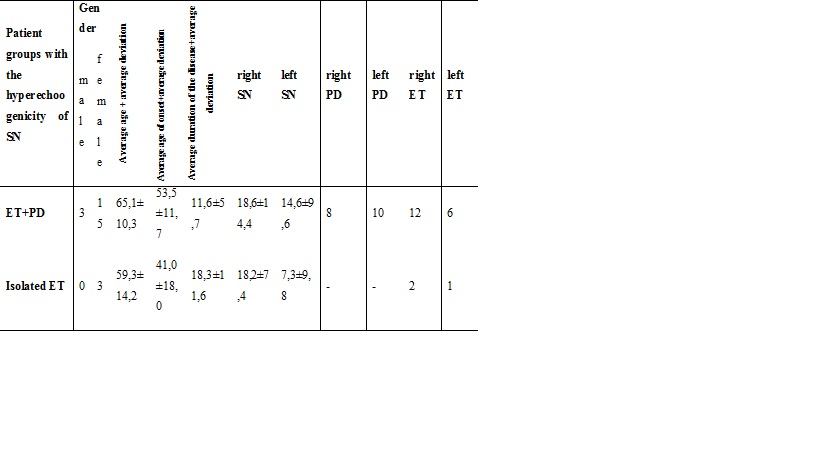Category: Tremor
Objective: To identify differential clinical and neurosonographic criteria for ET and PD in patients with familial ET.
Background: ET and PD are common disorders, especially in an aging population, and can be combined. In one family, there may be patients with isolated ET and ET+PD.These arguments are the basis for the search for PD predictors in patients with ET and biomarkers of these two conditions [1]. Transcranial sonography (TS) is a highly sensitive and specific method for diagnosing Parkinson’s disease (sensitivity is 91%, specificity is 87%) [2].
Method: We examined 57 patients with the hereditary ET. The design of the study included clinical and neurosonographic methods (TS), statistical methods.
Results: Of the 57 patients with ET and ET + PD, 21 patients according to the TS revealed hyperechoogenicity of SN (in 36.8%); values of hyperechoogenicity of SN more than 20 mm² only in 10 of them (17.5% of all patients with familial ET). But, as in patients with values of hyperechoogenicity of SN below the threshold, symptoms of parkinsonism were detected, and, conversely, in some patients with values above the threshold, symptoms of parkinsonism were not detected. Further, patients with hyperechoogenicity of SN were divided into 2 subgroups: with manifestations of ET + PD (31.6% of all patients) and without PD (5.2%) (Table 1). In all men in the ET+PD group, manifestations of parkinsonism were noted on the left and the hyperechoogenicity of SN was more pronounced on the right, and ET in 2/3 of the cases on the right. Parkinson’s disease is probably an independent disease in men with ET.
Conclusion: In 36.8% of patients with ET, hyperechoogenicity of SN was revealed. In 31.6% of patients with ET and with hyperechoogenicity of SN, manifestations of parkinsonism were noted. In 5.2% of patients with isolated ET hyperechoogenicity of SN values were higher than the threshold, i.e. hyperechoogenicity of SN isn’t a reliable predictor of the clinical joining of PD. In males, hyperechoogenicity of SN was determined by the contralateral akinetic-rigid syndrome. In the ET group, the hyperechoogenicity of SN didn’t correspond to the side of the severity of ET. No age-related features, indicators of experience and age of onset of the disease in patients with ET + PD were revealed.
References: 1. K.P. Bhatia, P. Bain, N. Bajaj, R.J. Elble, M. Hallett, E.D. Louis, J. Raethjen, M. Stamelou, C.M. Testa, G. Deuschl, a.t.T.T.F.o.t.I.P.a.M.D. Society, Consensus statement on the classification of tremors, from the TaskForce on Tremor of the International Parkinson and Movement Disorder Society, MovDisord(Inpress) 2. Shafieesabet A., Fereshtehnejad S.M., Shafieesabet A. et al. Hyperechogenicity of substantia nigra for differential diagnosis of Parkinson’s disease: A meta-analysis. ParkinsonismRelatDisord 2017; 42: 1–11. DOI: 10.1016/j.parkreldis.2017.06.006. PMID: 28647434
To cite this abstract in AMA style:
S. Munasipova, Z. Zalyalova. Neurosonography of substantia nigra in patients with isolated essential tremor and in association with Parkinson’s disease of the family nature [abstract]. Mov Disord. 2020; 35 (suppl 1). https://www.mdsabstracts.org/abstract/neurosonography-of-substantia-nigra-in-patients-with-isolated-essential-tremor-and-in-association-with-parkinsons-disease-of-the-family-nature/. Accessed January 7, 2026.« Back to MDS Virtual Congress 2020
MDS Abstracts - https://www.mdsabstracts.org/abstract/neurosonography-of-substantia-nigra-in-patients-with-isolated-essential-tremor-and-in-association-with-parkinsons-disease-of-the-family-nature/

